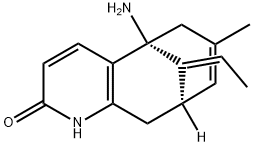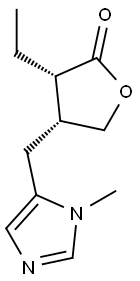PRODUCT Properties
| Melting point: | 102-104 °C(lit.) |
| alpha | D17 -76° (c = 1.3 in chloroform); D25 -120° (benzene) |
| Boiling point: | 418.29°C (rough estimate) |
| Density | 1.166±0.06 g/cm3 (20 ºC 760 Torr) |
| refractive index | 1.5600 (estimate) |
| Flash point: | >100℃ |
| storage temp. | 2-8°C |
| solubility | Chloroform (Slightly, Sonicated), DMSO (Slightly), Ethanol (Slightly), Methanol |
| form | Powder |
| pka | 6.12, 12.24(at 25℃) |
| color | Off-white |
| optical activity | -12025 (CHCl3) |
| Water Solubility | Soluble in water (1:75), alcohol (1:10), chloroform (1:1), ether (1:30), and DMSO. |
| Sensitive | Air & Light Sensitive |
| Merck | 7384 |
| CAS DataBase Reference | 57-47-6(CAS DataBase Reference) |
| EPA Substance Registry System | Physostigmine (57-47-6) |
Description and Uses
The classic AChEI, physostigmine, is an alkaloid obtained from seeds of the Calabar bean (Physostigma venenosum). Its parasympathomimetic effects were recognized long before its structure was elucidated in 1923. In 1929, Stedman found that the mechanism of the parasympathomimetic effects of physostigmine was inhibition of AChE; it inhibits AChE by acting as a substrate and carbamylating the enzyme. Acetylcholinesterase is carbamylated at a slow rate, but physostigmine has exceptionally high affinity (Ki ~ 10-9 M) for the catalytic site of the enzyme. By comparison, the Ks for acetylcholine is on the order of 10-4 M. Thus, physostigmine is classified as a reversible AChEI that carbamylates the enzyme at a slow rate; the carbamylated AChE also is regenerated quite slowly. Because physostigmine is a tertiary amine with a pKa of 8.2 (+BH) rather than a quaternary ammonium salt, it is more lipophilic than many other AChEIs and can diffuse across the blood-brain barrier. The tertiary amine also imparts pH dependence to its ability to inhibit AChE, because its affinity for AChE is greater when the amine is protonated.
It is a parasympathomimetic, specifically, a reversible cholinesterase inhibitor obtained from the Calabar bean, used to treat glaucoma and delayed gastric emptying.
Safety
| Symbol(GHS) |  GHS06 |
| Signal word | Danger |
| Hazard statements | H300-H330-H300+H330 |
| Precautionary statements | P301+P310a-P304+P340-P320-P330-P405-P501a-P260-P284-P301+P310+P330-P304+P340+P310-P403+P233 |
| Hazard Codes | T+ |
| Risk Statements | 26/28 |
| Safety Statements | 23-45-25 |
| RIDADR | UN 1544 6.1/PG 1 |
| WGK Germany | 3 |
| RTECS | TJ2100000 |
| F | 8-10 |
| TSCA | Yes |
| HazardClass | 6.1(a) |
| PackingGroup | II |
| Hazardous Substances Data | 57-47-6(Hazardous Substances Data) |
| Toxicity | LD50 orally in mice: 4.5 mg/kg (Lynch, Coon) |




